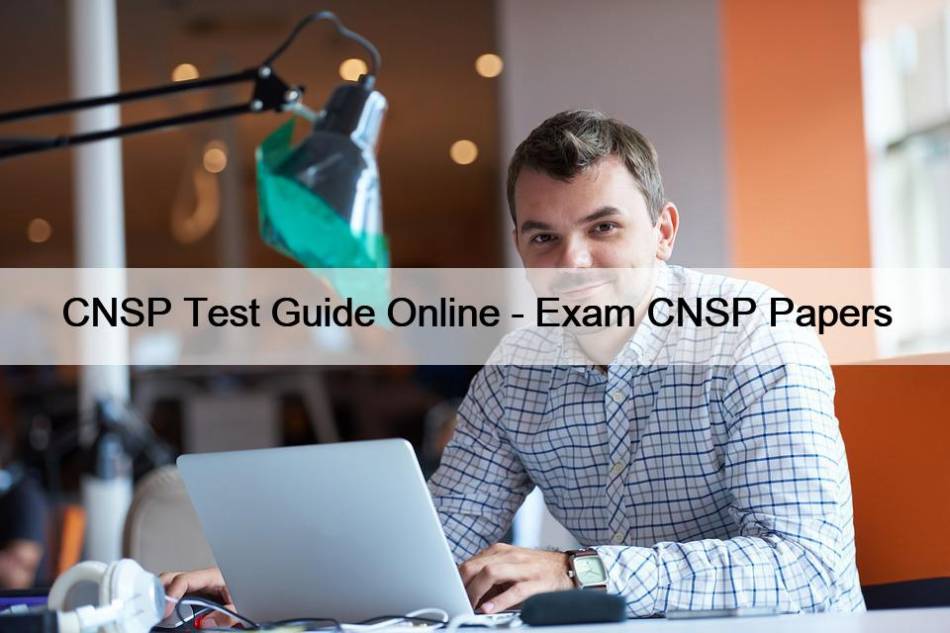Most Popular
 Reliable Google-Workspace-Administrator Test Guide - Reliable Google-Workspace-Administrator Test Online
Reliable Google-Workspace-Administrator Test Guide - Reliable Google-Workspace-Administrator Test Online
BONUS!!! Download part of ITdumpsfree Google-Workspace-Administrator dumps for free: https://drive.google.com/open?id=1IhTFEOV_kV95-JQhKIQEOIS0fgxhoM8OYou ...
 1D0-1065-23-D Review Guide - 1D0-1065-23-D Latest Exam Review
1D0-1065-23-D Review Guide - 1D0-1065-23-D Latest Exam Review
We have an authoritative production team, after you purchase 1D0-1065-23-D ...
 C-TS414-2023 Valid Test Objectives, C-TS414-2023 Valid Test Book
C-TS414-2023 Valid Test Objectives, C-TS414-2023 Valid Test Book
DOWNLOAD the newest Prep4SureReview C-TS414-2023 PDF dumps from Cloud Storage ...



CNSP Test Guide Online - Exam CNSP Papers

Completing the preparation for the The SecOps Group CNSP exam on time is the most important aspect. The other thing is to prepare for the The SecOps Group CNSP exam by evaluating your preparation using authentic exam questions. ITexamReview provides the most authentic The SecOps Group CNSP Exam Questions compiled according to the rules and patterns supplied by CNSP.
The SecOps Group CNSP Exam Syllabus Topics:
| Topic | Details |
|---|---|
| Topic 1 |
|
| Topic 2 |
|
| Topic 3 |
|
| Topic 4 |
|
| Topic 5 |
|
| Topic 6 |
|
| Topic 7 |
|
| Topic 8 |
|
| Topic 9 |
|
| Topic 10 |
|
| Topic 11 |
|
| Topic 12 |
|
| Topic 13 |
|
| Topic 14 |
|
| Topic 15 |
|
| Topic 16 |
|
Quiz Professional CNSP - Certified Network Security Practitioner Test Guide Online
The clients can try out and download our CNSP study materials before their purchase. They can immediately use our CNSP training guide after they pay successfully. Our expert team will update the study materials periodically to make sure that our worthy customers can always have the latest and valid information. And if the clients encounter the problems in the course of using our CNSP Learning Engine, our online customer service staff will enthusiastically solve their problems.
The SecOps Group Certified Network Security Practitioner Sample Questions (Q45-Q50):
NEW QUESTION # 45
What is the response from a closed TCP port which is not behind a firewall?
- A. ICMP message showing Port Unreachable
- B. A SYN and an ACK packet
- C. A FIN and an ACK packet
- D. A RST and an ACK packet
Answer: D
Explanation:
TCP uses a structured handshake, and its response to a connection attempt on a closed port follows a specific protocol when unobstructed by a firewall.
Why C is correct: A closed TCP port responds with a RST (Reset) and ACK (Acknowledgment) packet to terminate the connection attempt immediately. CNSP highlights this as a key scanning indicator.
Why other options are incorrect:
A: ICMP Port Unreachable is for UDP, not TCP.
B: FIN/ACK is for closing active connections, not rejecting new ones.
D: SYN/ACK indicates an open port during the TCP handshake.
NEW QUESTION # 46
Which command will perform a DNS zone transfer of the domain "victim.com" from the nameserver at 10.0.0.1?
- A. dig @10.0.0.1 victim.com afxr
- B. dig @10.0.0.1 victim.com axrfr
- C. dig @10.0.0.1 victim.com axfr
- D. dig @10.0.0.1 victim.com arfxr
Answer: C
Explanation:
A DNS zone transfer replicates an entire DNS zone (a collection of DNS records for a domain) from a primary nameserver to a secondary one, typically for redundancy or load balancing. The AXFR (Authoritative Full Zone Transfer) query type, defined in RFC 1035, facilitates this process. The dig (Domain Information Groper) tool, a staple in Linux/Unix environments, is used to query DNS servers. The correct syntax is:
dig @<nameserver> <domain> axfr
Here, dig @10.0.0.1 victim.com axfr instructs dig to request a zone transfer for "victim.com" from the nameserver at 10.0.0.1. The @ symbol specifies the target server, overriding the system's default resolver.
Technical Details:
The AXFR query is sent over TCP (port 53), not UDP, due to the potentially large size of zone data, which exceeds UDP's typical 512-byte limit (pre-EDNS0).
Successful execution requires the nameserver to permit zone transfers from the querying IP, often restricted to trusted secondaries via Access Control Lists (ACLs) for security. If restricted, the server responds with a "REFUSED" error.
Security Implications: Zone transfers expose all DNS records (e.g., A, MX, NS), making them a reconnaissance goldmine for attackers if misconfigured. CNSP likely emphasizes securing DNS servers against unauthorized AXFR requests, using tools like dig to test vulnerabilities.
Why other options are incorrect:
A . dig @10.0.0.1 victim.com axrfr: "axrfr" is a typographical error. The correct query type is "axfr." Executing this would result in a syntax error or an unrecognized query type response from dig.
B . dig @10.0.0.1 victim.com afxr: "afxr" is another typo, not a valid DNS query type per RFC 1035. dig would fail to interpret this, likely outputting an error like "unknown query type." C . dig @10.0.0.1 victim.com arfxr: "arfxr" is also invalid, a jumbled version of "axfr." It holds no meaning in DNS protocol standards and would fail similarly.
Real-World Context: Penetration testers use dig ... axfr to identify misconfigured DNS servers. For example, dig @ns1.example.com example.com axfr might reveal subdomains or internal IPs if not locked down.
NEW QUESTION # 47
How many usable TCP/UDP ports are there?
- A. 0
- B. 1
- C. 2
- D. 3
Answer: D
Explanation:
TCP (Transmission Control Protocol) and UDP (User Datagram Protocol) port numbers are defined by a 16-bit field in their packet headers, as specified in RFC 793 (TCP) and RFC 768 (UDP). A 16-bit integer ranges from 0 to 65,535, yielding a total of 65,536 possible ports (2
Tags: CNSP Test Guide Online, Exam CNSP Papers, Exam CNSP Pass4sure, CNSP New Learning Materials, Latest CNSP Test Simulator